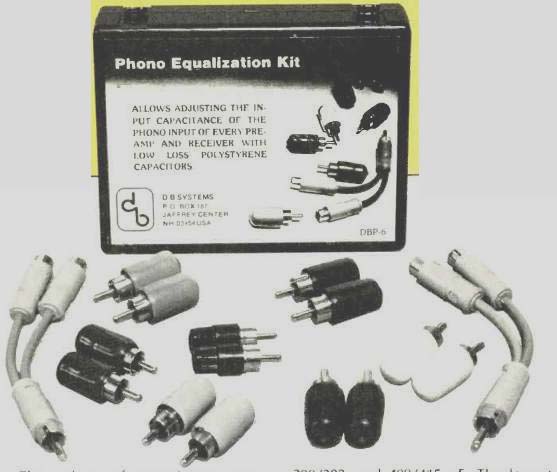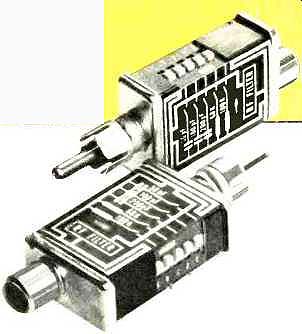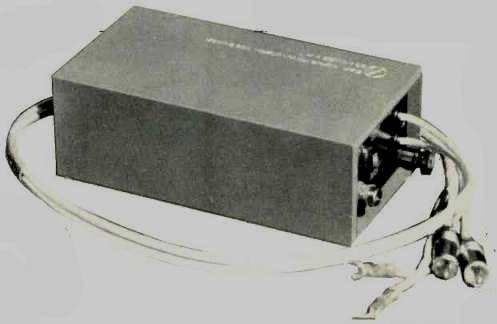In the past two years, quite a few articles have been written on the cartridge-preamplifier interface. An excellent discussion of the possible problems appeared in the article by Tomlinson Holman in Audio, February, 1977. As Mr. Holman pointed out, the capacitive load presented to the cartridge is very important in determining its performance, and many cartridges and preamps do not make the best possible combination. The resistive termination is also important, and discrepancies were found in this area as well. Recently, a number of manufacturers have introduced preamps with switchable loading, and the trend to include this is expected to continue.
For the audiophile who wants this refinement but is reluctant to replace his present preamp, there are two possible approaches. For one thing, he can dig out the trusty soldering iron and add shunt capacitance on the phono inputs to make the total with the cables equal to the pickup manufacturer's recommended value. A change in the terminating resistor may also be called for. Some trial and error may be involved to get the preferred sound, of course. If you shy away from even simple circuit modifications or if you expect to be changing cartridges with some regularity, the use of one of the products discussed below would be a better way to go.

DB Systems DBP-6 Phono Equalization Kit
Scheme: Phono "Y" adapter with capacitor plugs.
Capacitor Selection: 100, 150, 200, 300, and 400 pF (picofards).
Resistive Load: 100 ohms for moving-coil cartridge.
Price: $24.95.
DB Systems DBP-6
This phono equalization kit is simple in construction and use. The turn table leads are disconnected, and the supplied phono Ys are installed with the desired added capacitance on one arm and the phono lead reconnected to the other. All such connections, of course, should be made in a no-power or at least volume-down condition, making it slightly difficult to make A-B tests. DB Systems provides listings of load requirements for many cartridges and of tonearm and output cable capacitances for the great majority of units. These lists are very useful, particularly, as many manufacturers do not supply much information.
DB Systems tells us that they will shortly bring out a capacitance switch box to allow changing capacitance while listening. Values from 100 to 400 pF can be independently selected for either of two cartridges, and the projected price is $75.00.
The values of capacitance were measured with a GR impedance bridge, and the results include the effect of the Ys. There was a set of two for each value, of course, and they were always in close agreement. The values were as follows, for nominal/ measured: 100/112, 150/144, 200/207, 300/302, and 400/415 pF. The largest percentage discrepancy was at 100 pF, but it was not considered significant.
The capacitors all had very high Qs, excellent quality. The "100-ohm" moving-coil plugs had measured values of 99.9 and 99.8 ohms--how close can you get?
---------------

Berkshire Audio Products Match-Maker
Scheme: Small box, suitable for direct plug-in with separate switches for 3 values of capacitance and 2 values of resistance.
Capacitor Selection: 50, 100, 150, 200, 250, 300, and 350 pF, by choice of 50, 100, and 200 pF values.
Resistive Shunts: 68 and 100 kilohms.
Price: $49.95.
Berkshire Audio Products Model CCM
Capacitance Meter Range: 0 to 1000 pF.
Resolution: 25 pF.
Meter Accuracy: 5 percent.
Price: $89.95.
Berkshire Audio Match-Makers & CCM Meter
This is a compact assembly with five computer-type slide switches, a phono jack for the turntable cable, and a phone plug for connection to the preamp. Three of the switches provide On/Off selection for capacitance of 50, 100, or 200 pF individually or can be used in combinations up to a total of 350 pF. The other two switches function the same way for resistors of 68 and 100 kilohms, with the load also affected by any termination already in the preamp. The unit also includes an r.f. filter. The design makes it possible to change the loading while listening, a helpful feature.
The pair of units provided had capacitance values very close to each other. The bridge gave the following results, nominal/measured: 50/58, 100/114, 150/157, 200/191, 250/236, 300/290, and 350/334 pF. The largest percentage discrepancy was at 50 pF, but the actual difference was only 8 pF. All measured Qs were high, indicating very good capacitor quality. The "68K" resistors were 69 kilohms, and the "100K" resistors were 98.5 and 100 kilohms, plenty close enough. The built-in r.f. filter was 6 dB down at 1.4 Mhz.
The Model CCM capacitance meter from Berkshire Audio Products is a compact, simple-to-operate means of measuring the capacitance load presented to a cartridge, including the in put capacitance of the preamp. The battery-powered device includes zeroing and a calibration-set function, referenced to an internal capacitor.
The scale is from 0 to 500 pF, but readings are possible to 1000 pF if the calibration is set to half its normal indication. Zeroing and calibration were straightforward and measurements were easily made. The percentage errors were greatest for small values of capacitance as there was a constant discrepancy of about 20 pF (not significant) compared to results with the bridge.
In-Use Test
The two matching systems were used with two different turntable systems, although with the same preamp.
Many types of music were played with discs of various ages. There was no doubt about the noticeable improvement in the sound in most cases with either scheme with a total capacitance just a little less than that recommended by the cartridge manufacturer. The exceptions were a few discs that were too peaky with the added capacitance and a couple over-the-hill discs that showed more shatter. If you don't want to get into the try-and-solder routine, either approach could be very worthwhile for your system. The DB Systems kit provides what you need most of all at lower cost. The Berkshire Audio Match-Maker allows making changes more conveniently and provides resistive termination switching as well, albeit at twice the cost. The CCM capacitance meter would be high in price for many audiophiles, but one might be shared, and such a unit would be good for dealers to have for loan and demonstration.
-Howard A. Roberson

Cotter Model MK-2 Transformer
MANUFACTURER'S SPECIFICATIONS:
Frequency Response: 3 Hz to > 150 kHz.
Channel Separation: >100dB.
Square Wave Rise Time: < 3 N S.
Phase Linearity (10-30,000 Hz): ±2°.
Type X
Special order, made to specification.
Type S
D.C. Resistance: < 12 ohms referred to primary.
Voltage Ratio: 8.88 to 1 Gain: 19 dB.
Pickup Impedance Range: 20 ohms higher.
Type PP
Specifications same as Type S, but optimized for a specific pickup in the 20- to 30-ohm impedance range.
Type P
D.c. Resistance: < 3 ohms referred to primary.
Voltage Ratio: 16.8 to 1.
Gain: 24.5 dB.
Pickup Impedance Range: 2 to 30 ohms.
General Specifications:
Dimensions: 2 in. (5 cm) D x 3 in. (7.6 cm) W x 5 1/8 in. (15 cm) L.
Input: RCA jacks.
Output: 24-in. (61 cm) triaxial cable terminated with special precision RCA plugs.
Lugs on each cable plus binding post for turntable and arm-shell.
Price: $450.00; re-strapping, $35.00 plus shipping.
When we first saw this transformer, we wondered what in it could be worth such a high price. After examining the transformer in detail and discussing its construction and use with maker Mitch Cotter by phone, we are reasonably well convinced that the materials used in the construction of this transformer and the tender, loving care lavished upon each unit during construction could well be worth this price.
The MK-2 step-up transformer consists of two individual, non-toroidal transformers, one for each stereo channel. Both primary coil windings are absolutely identical and, similarly, the coils making up the secondary windings are also absolutely identical. All coils are terminated on a wiring strip be hind the input-output panel of the transformer. It is here that the many windings are brought together in the configuration required to obtain the desired impedance and voltage gain.
The input connectors are RCA jacks, and the outputs are two 24-inch triaxial cables terminated in special precision RCA plugs. These plugs are made by Cotter Co. The outputs have both a system ground and an audio ground. The RCA plugs have the usual audio ground when properly connected, but the ground lugs associated with each output cable must be connected to the system ground since their other end is connected to the transformer shell and the outer shield of the cable. This type of grounding reduces electrostatically and electromagnetically induced noise to an insignificant figure.
The output cables are connected directly to the phono input of the preamplifier. If the turntable is located too far from the rest of the system, the manufacturer recommends that the cables from the table to the transformer be extended, rather than the output cables from the transformer. Triaxial cables to extend the cable length from the table to the transformer are available from the manufacturer.
The MK-2 is immune to noise, utilizing a seven-element, magnetic-lens shield design and triaxial cable for the output.
The triaxial cable completely shields the signal-carrying path from any outside interference by means of a third conductor completely encompassing the inner two signal-carrying conductors.
Measurements
Like all transformers, the MK-2 requires neither an a.c. power source nor batteries since it is a very efficient passive device. The transformer is available in one of four types, with each type having the capability of being transformed to any other type at the factory. Any tampering with the terminal strapping automatically terminates the warranty.
Type P is for very low impedance cartridges (2 to 30 ohms) such as the Nakamichi, Supex, Ortofon, Entré, GAS, Fidelity Research, Signet, and other similar types for which it provides the highest signal-to-noise ratio.
Type S is for cartridges of 20 ohms and higher, such as the Denon and the Satin, for which it supplies the appropriate gain and gives the best low-frequency response.
Type PP is optimized for phono cartridges in the 20- to 30-ohm range, such as the EMT. However, it is possible to uses either the Type P or S for cartridges in the 20- to 30-ohm range, but the transformer will not necessarily be optimized for these cartridges.
Type X is for special requirements where the transformer is optimized for a given cartridge and preamplifier combination in order to obtain the best performance possible from the particular cartridge.
In the laboratory, we confirmed that the gain of the Type S and Type P is 19 dB and 24.5 dB, respectively. This is sufficient gain for just about any moving-coil cartridge, however, the gain is insufficient for the ribbon (velocity) cartridge such as the Nagatron HV9100, which requires a minimum gain of 35 dB and preferably around 40 dB. We know of no moving-coil or ribbon cartridge that can overload this transformer at any audible frequency.
We tried to induce hum into the system by placing the transformer on top of an autotransformer and into a magnetic field, but without success. We concluded that the shielding used in this device is very efficient.
The frequency response is flat to well beyond 100 kHz and a 1000-Hz square wave is relatively flat on both the top and bottom.
Listening & Use Tests
We auditioned both the Type P and S step-up transformers with a variety of moving-coil cartridges, using our special test preamplifier and the Crown IC-150 A and the Nikko Beta 1 preamplifiers connected to our music system. At no time were we able to discern an aural signal degradation due to the transformer, and it was quite apparent that the MK-2 introduces no coloration or sound of its own, performing in all aspects as claimed by the manufacturer. We can recommend this transformer without hesitation to anyone in need of such a device for their moving-coil cartridge.
About the only criticism which can be made is really not of the unit itself, but rather of its initial high price, plus the high cost of converting the unit to another configuration for a different moving-coil cartridge whose impedance is significantly different from the first cartridge. What might be done here is to offer one or two free conversions for any single transformer. Should this be done, the MK-2 transformer would then be much more reasonably priced in today's market place.
--B.V. Pisha
(Source: Audio magazine, Mar. 1979)
Also see:
Phoenix Systems P-10-MM Phono Preamp (May 1983)
New Tests for Preamplifiers (by Tomlinson Holman) (Feb. 1977)
Birth of a Spec? PHONO CARTRIDGE NOISE (March 1977)
= = = =